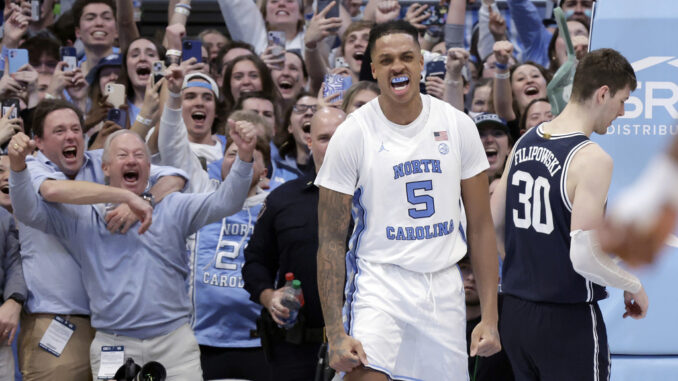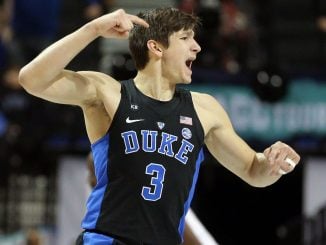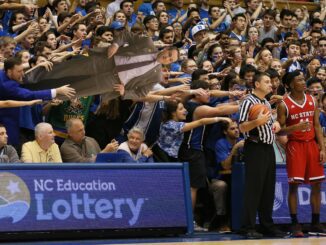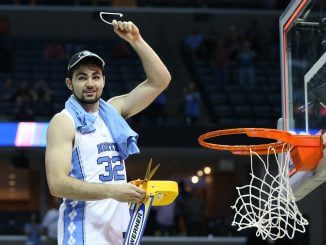
CHAPEL HILL — It’s the rivalry to end all rivalries — an epic struggle, a spectacle. It’s hyped beyond belief and almost always finds a way to live up to the promise.
But does Carolina-Duke really matter?
Obviously, as two elite programs and the flagship teams in the ACC, UNC and Duke both matter a great deal in college basketball. That early February clash, though — the one that opens college basketball’s desperate season — does it matter?
In other words, UNC got the better of Duke in this season’s opening round of the rivalry. What does it mean? What, if anything, have we learned about either team?
Consider this: Combined, UNC and Duke have won 11 NCAA Tournaments. Six times, the winner of that year’s UNC-Duke I cut down the final net of the season. Five times, the loser did.
Combined, the Tar Heels and Blue Devils have played in 38 Final Fours. The loser of the first Duke-Carolina game went to 18 of them, the winner, 20.
In other words, if you were told before the first rivalry game that one of the teams playing will have a season for the ages, actually watching the game is only marginally more informative than just flipping a coin in identifying which one of the two it is.
There are likely several reasons for this. First, winning a Duke-Carolina game demands that a team dig deep into its well of emotion. If any regular season game is a test of “who wants it more,” it’s that one. Is the team that can find that little bit extra one night in early February necessarily the one that will do so a month and a half later? History says “not necessarily.”
Then there’s the motivation factor. Losing to your most hated foe is a wake-up call. Duke coach Jon Scheyer summed up that attitude after UNC’s 93-84 win on Saturday, saying, “I know the teams I’ve played on, coached on — we compete. We show up. Tonight wasn’t the level that it should be.”
Finally, the calendar may say it’s just a month, but it’s a long way to March. Players have a lot of developing, healing and maturing to go before the postseason begins. Players who got a brief cameo in the first Duke-Carolina game can become March legends.
Freshman Grayson Allen scored two points in four minutes on the court against the Tar Heels in February 2015 then saved Duke’s season with a Final Four explosion. Donald Williams scored seven points at Cameron in early 1993, then won the Final Four Most Outstanding Player seven weeks later. Luke Maye scored eight points in Cameron in 2017. A month later, he became LUKE MAYE with an epic shot against Kentucky.
So, with the understanding that there’s a good chance Caleb Foster may break out and lead Duke to the Final Four this year, what can we take away from the Tar Heels’ big win?
Carolina’s defense is legit: The Tar Heels have looked fierce on defense during ACC play, but locking down Wake Forest and Boston College is not the same as putting a top-10 team like Duke through the wringer. The Blue Devils never seemed to find a rhythm on offense, and much of that was due to UNC smothering them.
Seth Trimble is an X-factor: From Marcus Ginyard to Theo Pinson to Brandon Robinson to Leaky Black, one common thread for elite Tar Heels teams is that they have a defensive specialist. Often, that seems to be code for “can’t (or shouldn’t) shoot.” Seth Trimble, proclaimed by Hubert Davis to be the team’s “best one-on-one defender,” seemed to be poised to join that club, and he had the minuscule 5.6 points per game scoring average to gain admission. However, his double-digit scoring performance against Duke and his willingness to attack the rim showed that he might have an offensive spark those other defensive whizzes didn’t flash quite so early in their UNC careers. Trimble outscored Cormac Ryan, Elliot Cadeau, Tyrese Proctor and, for much of the game, RJ Davis.
Kyle Filipowski needs to find his mojo: The reigning ACC player of the year had numbers that looked respectable — 22 points, five rebounds — but for much of the night, he struggled to keep up with Armando Bacot. Too often against UNC and in other recent games, Filipowski has been content to fire away from 3 instead of working his way inside. He was 1 for 6 from outside against UNC, and the Flip who lives outside the 3-point line isn’t as active or engaged as the one battling inside. When Scheyer says Duke’s competitive fire wasn’t at the level it needed to be, it’s a good bet that the 7-foot sophomore is one of the players to which he’s referring.
Jared McCain is ready for prime time: The shooter with all the TikTok followers has started most of the season, but the UNC game was one of the first times he seemed to truly star. The freshman led Duke with 23 points and 11 rebounds. He also was the one who found the fire everyone else in dark blue seemed to be lacking. “He’s a warrior,” said Scheyer.
So at this point, UNC appears to have the edge over its archrival, and the key players are clear. Of course, seasons aren’t judged by how things look in February’s first week. When the Valentine’s Day flowers still yet to be picked have long since withered and died, we’ll see which team has the right to brag — and which players are responsible.



